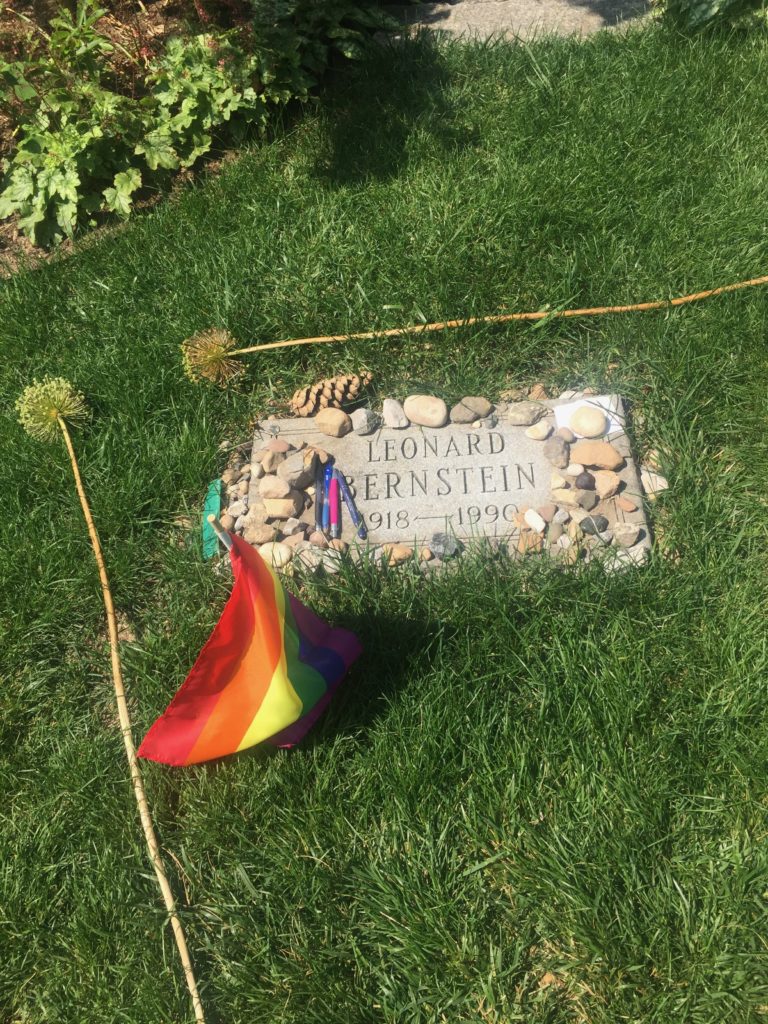Erik Visits an American Grave, Part 590
This is the grave of Leonard Bernstein and Felicia Montealegre Bernstein.


Louis Bernstein was born in Lawrence, Massachusetts in 1918 to Ukrainian Jewish immigrant parents. The family was upwardly mobile and they were able to buy a vacation home in Sharon, Massachusetts, where Louis spent a lot of time growing up. His parents always called him Leonard and they agreed to change his name when he was 15, after his grandmother, who always called him Louis, died. Leonard, or Lenny as he was usually known, was interested in music from a young age. His father, a businessman, initially opposed this as impractical, but eventually came around to supporting his talented son. Leonard became an outstanding pianist and went to Harvard in 1935, where he studied music. While there, he became close to the legendary conductor Dmitri Mitropoulos and the great composer Aaron Copland, both of whom became mentors and influences on Bernstein.
Bernstein graduated from Harvard in 1938, received more formal training at the Curtis Institute of Music in Philadelphia and then went to New York to make his way. He also took classes from Serge Koussevitzky, conductor of the Boston Symphony Orchestra. He continued to gain mentors and they worked hard for him, including Copland and Koussevitzky, who hired Bernstein as his conducting assistant. He first conducted a major orchestra in 1943 when the guest conductor came down with the flu. It so happened that this concert was broadcast on CBS Radio. The New York Times reviewed it with a rave. A star was born. He started conducting orchestras around the country as a favored guest conductor and was the music director for the New York City Symphony. He started composing more during the mid-1940s as well, including for symphonies and for musicals.
Bernstein had bad asthma and so did not fight in World War II. After the war, he became a major star in Europe too. He started conducting in Israel in 1947 and became a strong supporter of that nation. He went on television for the first time in 1949, conducting the Boston Symphony at Carnegie Hill on a show to celebrate the first anniversary of the UN Declaration of Human Rights (TV has changed a lot over the years!) and this also included a speech from Eleanor Roosevelt. In 1949, he conducted the premier performance of Messiaen’s masterful Turangalîla-Symphonie. And in 1951, he conducted the New York Philharmonic in the first ever performance of Charles Ives’ Symphony No. 2, which was 50 years old, but was never played before. Over the years, he became a major educator as well as conductor and composer, creating a show for young viewers, giving lectures on television, and teaching at Brandeis. He conducted Mahler’s Resurrection Symphony on national television for a memorial the day after JFK’s assassination. His own MASS, first performed in 1971 for the dedication of the Kennedy Center, was intended as an anti-war composition. It brought in influences from rock and roll and managed to infuriate the Catholic Church, which condemned the piece. On Christmas Day 1989, Bernstein conducted in both West and East Berlin to commemorate the end of the Cold War.
In 1951, Bernstein married Felicia Montealegre. She was born in 1922 in San Jose, Costa Rica. She was raised as a Catholic in Chile, but converted to Judaism when she married Bernstein. She had a Jewish grandfather anyway. She was an actress who appeared on some television productions, including playing Nora in a 1950 version of Ibsen’s A Doll House on Kraft Television Theatre. She was a reasonably prominent actor in New York for much of her life but never appeared in a movie. She was most known for pulling Bernstein to the left. It was at their apartment that Tom Wolfe visited the party where they hosted the Black Panthers in 1970; he wrote that up in his famous essay “Radical Chic: That Party at Lenny’s.” Montealegre also accepted, at least more or less, that her husband was gay. Many have speculated that he married her because he knew he would never get a major conducting gig if he was an out homosexual. They had three children and a good relationship, at least in the early years. In 1976, Bernstein finally came out of the closet and left her for Tom Cothran, the musical director of San Francisco’s classical music station. The next year, she developed lung cancer. Bernstein moved back in with her until her death in 1978.
Bernstein was basically out after 1978. He had a ten-year relationship with a Japanese insurance employee. In 1990, he had a massive heart attack. He died five days later, suffering from emphysema as well. His funeral procession went through the streets of Manhattan.
Conducting and classical music are not specialties of mine, so I will leave the details to you all in comments. Let’s watch some of Bernstein’s work.
Leonard Bernstein and Felicia Montealegre are buried in Green-Wood Cemetery, Brooklyn, New York.
If you would like this series to visit more figures of classical music, you can donate to cover the required expenses here. Aaron Copland is on the grounds of Tanglewood Music Center in the Berkshires and Charles Ives is in Fairfield, Connecticut. Previous posts in this series are archived here.


